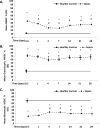Persistent Inflammation, Immunosuppression and Catabolism Syndrome
- PMID: 28284293
- PMCID: PMC5351769
- DOI: 10.1016/j.ccc.2016.12.001
Persistent Inflammation, Immunosuppression and Catabolism Syndrome
Abstract
Following advances in critical care, in-hospital multiple organ failure-related mortality is declining. Consequently, incidence of chronic critical illness is increasing. These patients linger in the intensive care unit, have high resource utilization, and poor long-term outcomes. Within this population, the authors propose that a substantial subset of patients have a new phenotype: persistent inflammation, immunosuppression, and catabolism syndrome. There is evidence that myelodysplasia with expansion of myeloid-derived suppressor cells, innate and adaptive immune suppression, and protein catabolism with malnutrition are major contributors. Optimal care of these patients will require novel multimodality interventions.
Keywords: Cachexia; Chronic critical illness; Multiple organ failure; Myeloid-derived suppressor cells; PICS; Sepsis; Shock; Trauma.
Copyright © 2016 Elsevier Inc. All rights reserved.
Figures





References
-
- Moore FA, Moore EE. Evolving concepts in the pathogenesis of postinjury multiple organ failure. The Surgical clinics of North America. 1995 Apr;75(2):257–277. - PubMed
-
- Waydhas C, Nast-Kolb D, Jochum M, et al. Inflammatory mediators, infection, sepsis, and multiple organ failure after severe trauma. Archives of surgery. 1992 Apr;127(4):460–467. - PubMed
-
- Faist E, Baue AE, Dittmer H, Heberer G. Multiple organ failure in polytrauma patients. The Journal of trauma. 1983 Sep;23(9):775–787. - PubMed
-
- Balogh Z, McKinley BA, Cox CS, Jr, et al. Abdominal compartment syndrome: the cause or effect of postinjury multiple organ failure. Shock. 2003 Dec;20(6):483–492. - PubMed
Publication types
MeSH terms
Grants and funding
LinkOut - more resources
Full Text Sources
Other Literature Sources

